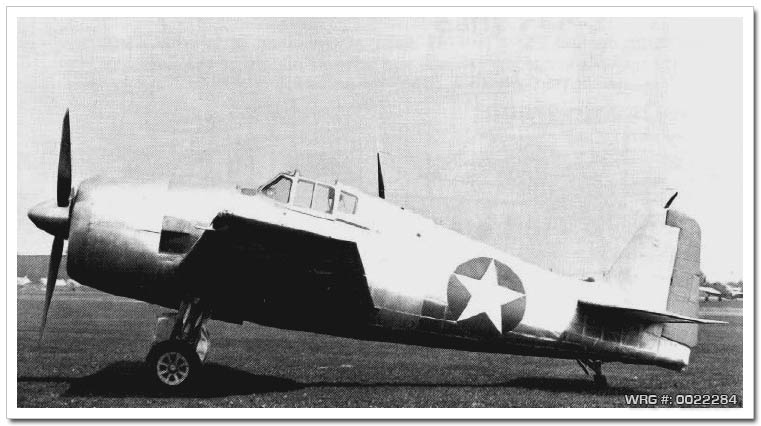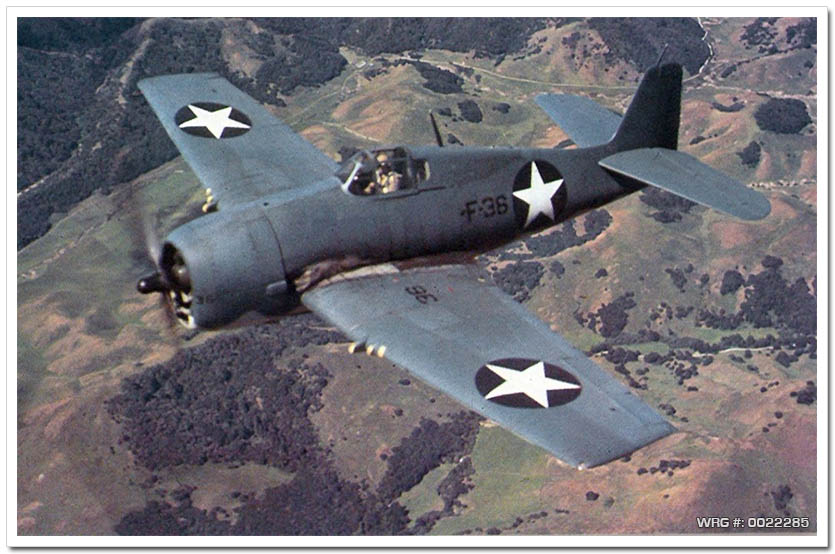U.S. NAVAL AVIATION RESOURCE CENTER > FIGHTERS > HELLCAT > PREVIOUS PAGE
Design & Development
The unpainted XF6F-1 prior to its first flight. Grumman had been working on a successor to the F4F Wildcat since 1938 and the contract for the prototype XF6F-1 was signed on 30 June 1941. The aircraft was designed to use the Wright R-2600 Twin Cyclone two-row, 14-cylinder radial engine of 1,700 hp driving a three-bladed Curtiss Electric propeller. Instead of the Wildcat's narrow-track, hand-cranked landing gear retracting into the fuselage, the Hellcat had wide-set, hydraulically actuated landing gear struts which rotated through 90° while retracting backwards into the wings, much like that of the earlier Chance Vought F4U Corsair. The wing was mounted lower on the fuselage and was able to be hydraulically or manually folded, with each panel outboard of the undercarriage bay folding backwards from pivoting on a specially oriented, Grumman-patented diagonal axis pivoting system much like the earlier F4F, with a folded stowage position parallel to the fuselage with the leading edges pointing down.

The unpainted Grumman XF6F-1 Hellcat fighter in 1942, prior to it's first flight.
[Source: U.S. Navy]
Based on combat accounts of encounters between the F4F Wildcat and A6M Zero, on 26 April 1942, BuAer directed Grumman to install the more powerful 18-cylinder Pratt & Whitney R-2800 Double Wasp radial engine in the second XF6F-1 prototype. Grumman complied by redesigning and strengthening the F6F airframe to incorporate the 2,000 hp (1,500 kW) R-2800-10, driving a three-bladed Hamilton Standard propeller. With this combination Grumman estimated the XF6F-3s performance would increase by 25% over that of the XF6F-1. The Cyclone-powered XF6F-1 (Bu. 02981) first flew on 26 June 1942, followed by the first Double Wasp-equipped aircraft, the XF6F-3 (Bu. 02982), which first flew on 30 July 1942. The first production F6F-3, powered by an R-2800-10, flew on October 3, 1942, with the type reaching operational readiness with VF-9 on USS Essex in February 1943.
Further Development
The F6F series were designed to take damage and get the pilot safely back to base. A bullet-resistant windshield and a total of 212 lb (96 kg) of cockpit armor was fitted, along with armor around the oil tank and oil cooler. A 250 gallon self-sealing fuel tank was fitted in the fuselage. Standard armament on the F6F-3 consisted of six .50 in. M2/AN Browning air-cooled machine guns with 400 rounds per gun. A center-section hardpoint under the fuselage could carry a single 150 gal disposable drop tank, while later aircraft had single bomb racks installed under each wing, inboard of the undercarriage bays; with these and the center-section hard point late model F6F-3s could carry a total bomb-load in excess of 2,000 lb. Six 5 in. HVARs (High Velocity Aircraft Rocket) could be carried; three under each wing on "zero-length" launchers.

A U.S. Navy Grumman F6F-3 Hellcat of fighter of VF-1 over California, in early 1943.
[Source: U.S. Navy]
The F6F-5 featured several improvements including a more powerful R-2800-10W engine, embodying a water-injection system and housed in a slightly more streamlined engine cowling, spring-loaded control tabs on the ailerons, and an improved, clear view windscreen, with a flat armored-glass front panel replacing the F6F-3's curved plexiglass panel and internal armor glass screen. In addition, the rear fuselage and tail units were strengthened, and, apart from some early production aircraft, the majority of the F6F-5's built were painted in an overall gloss sea blue finish. After the first few F6F-5s were built, the small windows behind the main canopy were deleted. The F6F-5N night fighter variant was fitted with an AN/APS-6 radar in a fairing on the outer-starboard wing. A small number of standard F6F-5s were also fitted with camera equipment for reconnaissance duties as the F6F-5P. While all F6F-5s were capable of carrying an armament mix of one 20 mm M2 cannon in each of the inboard gun bays (220 rounds per gun), along with two pairs of .50 in. machine guns (each with 400 rounds per gun), this configuration was only used on later F6F-5N night fighters. The F6F-5 was the most common F6F variant, with 7,870 being built.

A Grumman F6F-5 Hellcat fighter armed with HVAR rockets at the
Naval Ordnance Test Station at Inyokern, California, in 1944/45.
[Source: U.S. Navy]
The last Hellcat rolled out in November 1945, the total production being 12,275, of which 11,000 had been built in just two years. This high production rate was credited to the sound original design, which required little modification once production was underway.
Source:
Wikipedia
U.S. NAVAL AVIATION RESOURCE CENTER > FIGHTERS > HELLCAT > PREVIOUS PAGE
